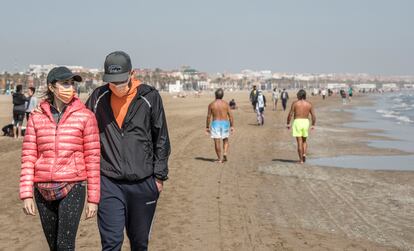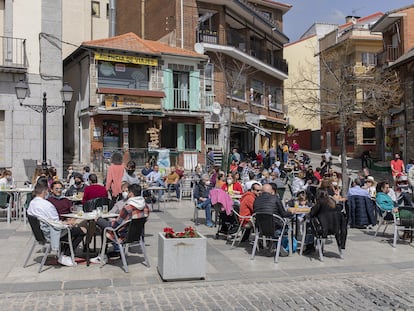Coronavirus incidence rising across Spain, apart from in the Canary Islands
Daily deaths, however, fell to just 85 on Monday, a figure that has been attributed to the near-complete vaccination of older, more at-risk groups
Easter week has broken the rising trend in Spain of the 14-day cumulative number of coronavirus cases per 100,000 inhabitants, the main parameter that is being used to follow the progress of the pandemic. This rate was at 138.63 for the whole country on March 23, and since then it went up one day, fell another, rose over the next two days and fell to 151.79 on April 3. In Monday’s report from the central Health Ministry the incidence reached 163.37.
Fernando Simón, the director of the Health Ministry’s Coordination Center for Health Alerts (CCAES), and the visible face of the government during the health crisis, explained that despite the effect that several holidays will have had on the reporting of the data, “the trend is on the rise,” and that this is before the figures started to reflect the increased movement of citizens during the Easter break.
While some of Spain’s regions continue to show an incidence below 100 – Baleares, Valencia, Galicia and Murcia – the data point is rising across the country. For example, only the Canary Islands have seen the incidence fall between the last coronavirus report, released on Saturday, and that of Monday. In the rest of the country’s territories, it has grown. If the latest report is compared with that of Friday, March 23, the incidence has risen in all regions apart from Asturias, Canary Islands, Extremadura and Galicia.

Measured by the number of positive cases reported by the regions, there were 10,360 new cases added to the total since Saturday. In terms of the cumulative total over seven days, the parameter refuses to fall: last Monday it came in at 36,506; yesterday barely a thousand fewer. In total, the Health Ministry has recorded 3,311,325 positive cases since the crisis began last year.
These variations in the data could correspond to the start of a fourth wave of the pandemic in Spain, but they could also indicate that this will not happen or that it will happen with different characteristics. This was suggested on Monday in Valencia by Health Minister Carolina Darias, given that there are more and more people who have been vaccinated. According to Health Ministry data, 2.8 million people have now got full protection from the Covid-19 vaccines being used in Spain, plus a further 5.9 million people with one of the two doses necessary. What’s more, there have been 3.3 million confirmed infections in Spain, as well as around 6.6 million people who contracted the coronavirus but are not part of the official data, according to the latest seroprevalence survey. All of these factors will influence a slower rise in the data than was seen previously, at the outset of the third wave. Back then, in the 21 days that passed after the data began to rise, the incidence grew 48% and did not go down on a single day. This time around, in the 21 days since the rise began in this potential fourth wave, it has risen less than half that, around 28%, and has seen rises and falls.
Simón also pointed to the occupation of hospitals by Covid-19 patients as a sign of a worsening situation, both in terms of general beds and those in intensive care units (ICUs). Looking at the variation between March 26 (the Friday before the Easter break) and the data from this Monday, the rate in normal wards has gone from 6.09% to 7.49%, and in ICUs, it has risen over the same period from 18.76% to 19.65%.
That said, the number of Covid-19 deaths reported in Monday’s report, just 85, is good news, explained Simón. The weekly total, 478, is the lowest since the second wave began to grow. In total, there have been 75,783 coronavirus victims recorded by the Spanish authorities. The CCAES director said on Monday that it is normal that the number of victims will be less affected now by rising infections, given that the most vulnerable population – i.e. the elderly – have been mostly vaccinated. According to Monday’s report, 90.7% of people living in care homes in Spain have now been fully vaccinated, while 79.1% of the over-80s have also got their two shots.
English version by Simon Hunter.
Tu suscripción se está usando en otro dispositivo
¿Quieres añadir otro usuario a tu suscripción?
Si continúas leyendo en este dispositivo, no se podrá leer en el otro.
FlechaTu suscripción se está usando en otro dispositivo y solo puedes acceder a EL PAÍS desde un dispositivo a la vez.
Si quieres compartir tu cuenta, cambia tu suscripción a la modalidad Premium, así podrás añadir otro usuario. Cada uno accederá con su propia cuenta de email, lo que os permitirá personalizar vuestra experiencia en EL PAÍS.
¿Tienes una suscripción de empresa? Accede aquí para contratar más cuentas.
En el caso de no saber quién está usando tu cuenta, te recomendamos cambiar tu contraseña aquí.
Si decides continuar compartiendo tu cuenta, este mensaje se mostrará en tu dispositivo y en el de la otra persona que está usando tu cuenta de forma indefinida, afectando a tu experiencia de lectura. Puedes consultar aquí los términos y condiciones de la suscripción digital.
More information
Últimas noticias
David Bowie, the galactic thinker who encouraged us to break new ground
John Berger and the loss of rural culture
From police officer to bloodthirsty kidnapper: Terror in Mexico during the years of ‘The Ear Chopper’
Alain Aspect, Nobel laureate in physics: ‘Einstein was so smart that he would have had to recognize quantum entanglement’
Most viewed
- David King, chemist: ‘There are scientists studying how to cool the planet; nobody should stop these experiments from happening’
- Reinhard Genzel, Nobel laureate in physics: ‘One-minute videos will never give you the truth’
- Oona Chaplin: ‘I told James Cameron that I was living in a treehouse and starting a permaculture project with a friend’
- Sinaloa Cartel war is taking its toll on Los Chapitos
- Mexico completes its trade shift with the entry into force of tariffs on China and countries without trade agreements









































